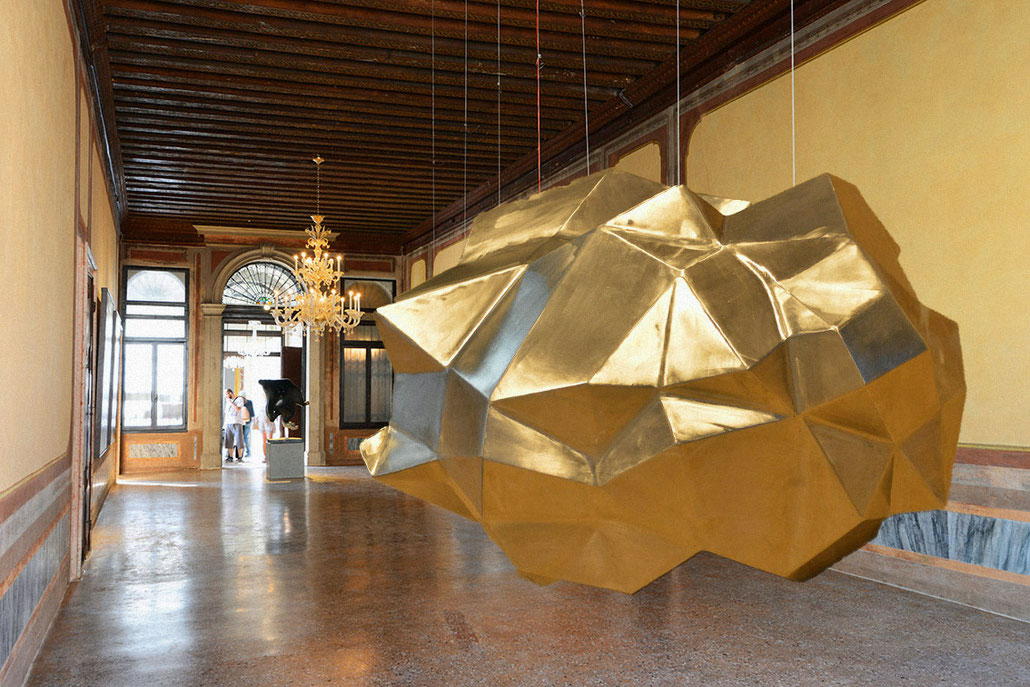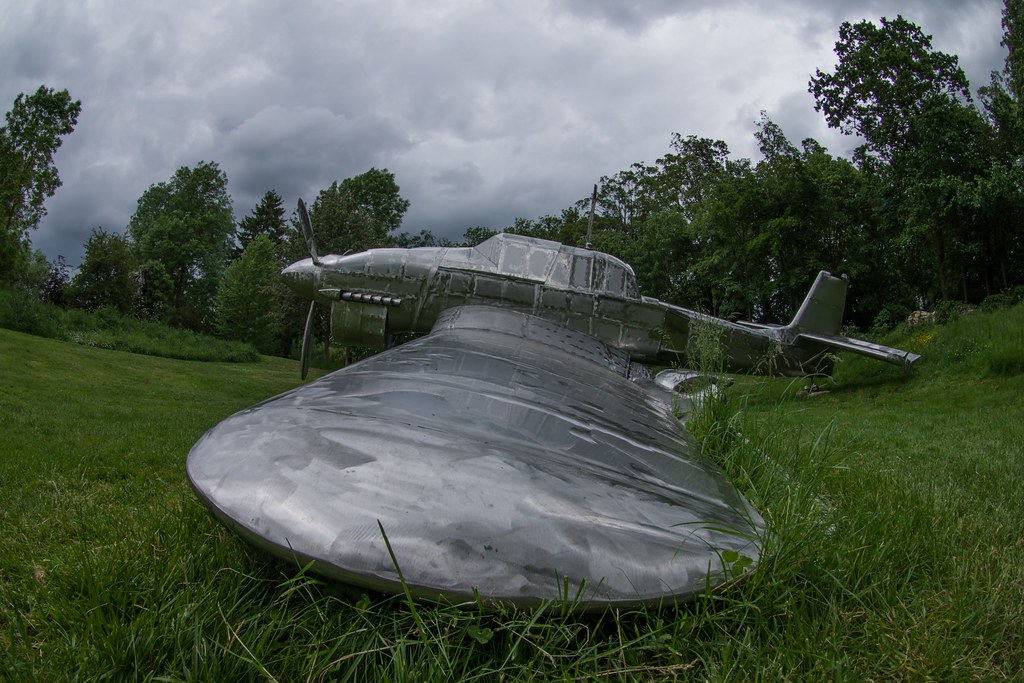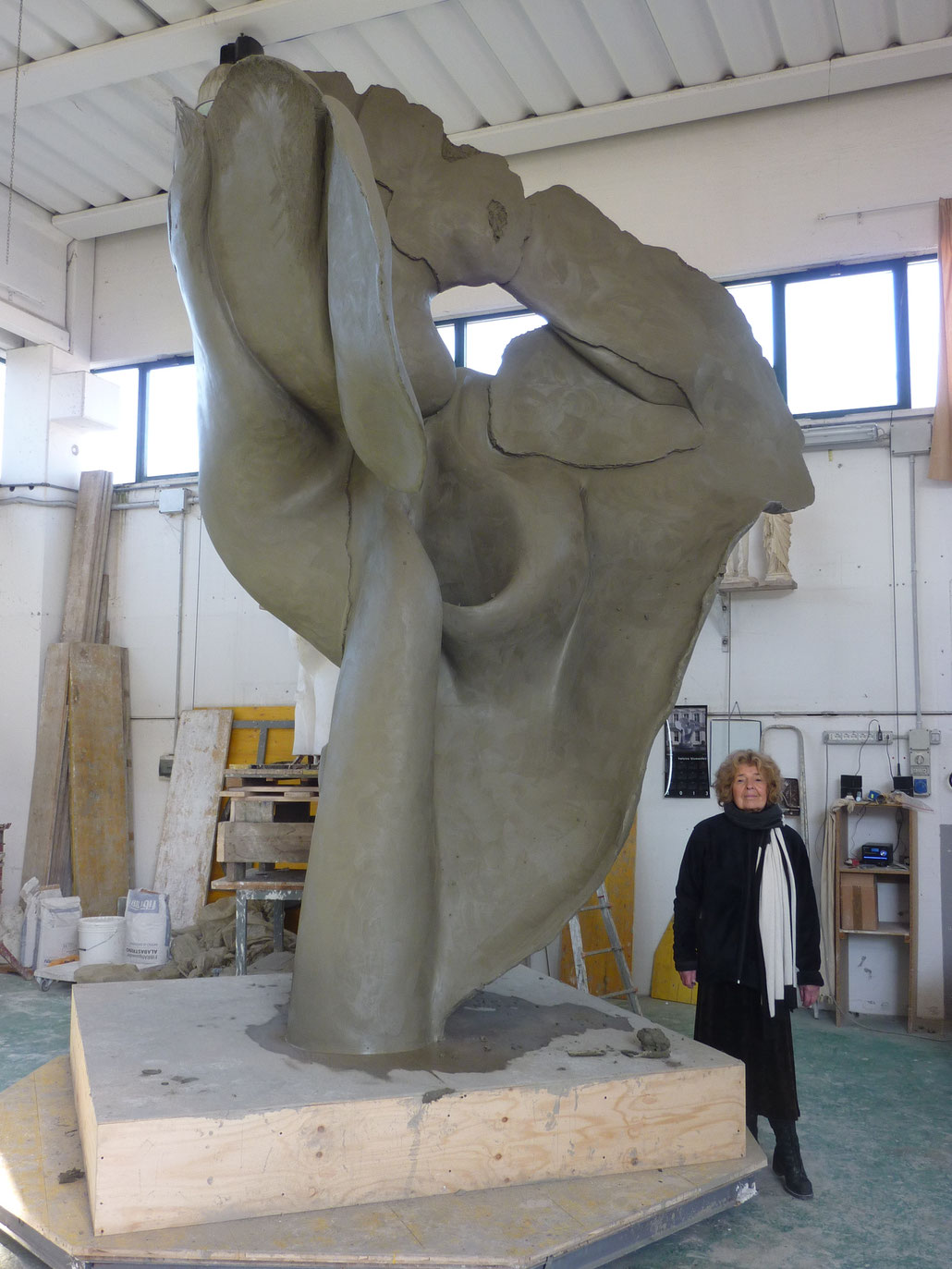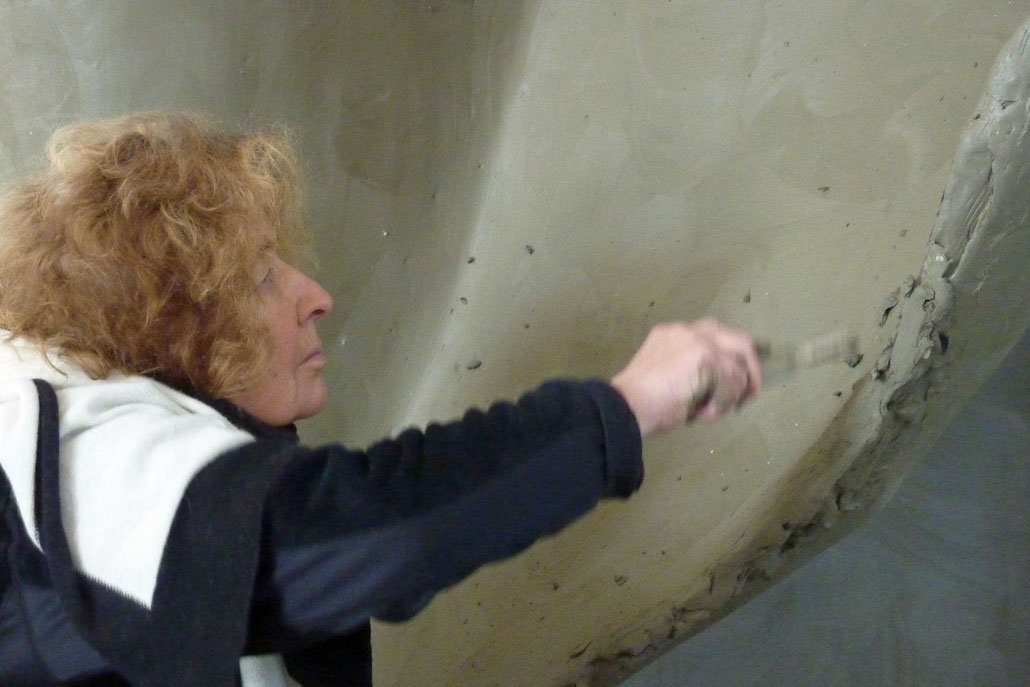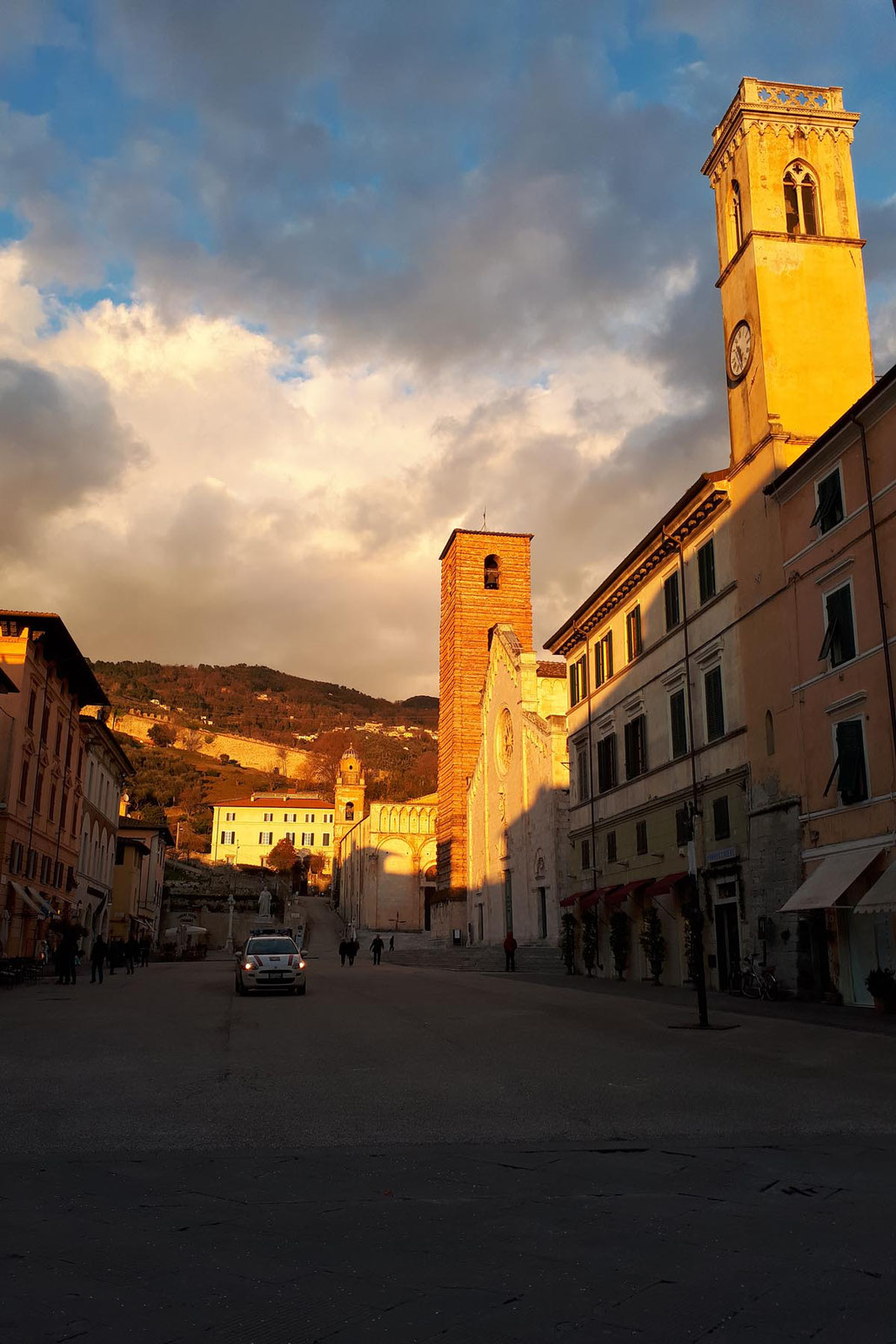"DOWN.TWO.EARTH."
im
Battle of Britain Memorial, Kent




"DOWN.TWO.EARTH." installed on March 8th 2020 at the Battle of Britain Memorial, Capel-Le-Ferne, Kent.
Due to the Corona crisis the pathway leading to the sculpture and the hedge has not been finished yet.




This Picture has been taken in February 2020. Behind the Spitfire and the Hurricane you can see the orange ribbon fencing in the foundation for my sculpture




Opening of "The Wing" by her Majesty The Queen. Gp Capt PSE Patrick Tootal OBE DL on the right.

Gp Capt PSE Patrick Tootal OBE DL and HEX during an BBC TV interview on February 28th 2020


Jörg van Hooven im Gespräch mit HEX für die Sendung "Menschen in München" bei München TV.


HEX in front of BURGHLEY HOUSE

The STUKA sculpture moves from Burghley House Sculpture Garden
to
The Battle of Britain Memorial, directly on the White Cliffs of Dover


A short movie about the Battle of Britain Memorial in Capel-Le-Ferne by Jon Peters Drone Media


Artist and art collector Bryan Hovercraft hugs Hex after purchasing the scale model


Left a replica of a Spitfire MK 1 and on the right a Hawker Hurricane





HEX and his assistant Piotr Galka are nearly finished with the raw Installation March 5th 2020





Venice, Biennale Interview with Prof. Dr. Hans-Peter Noll CEO of RAG Stiftung and the World Heritage Site Zeche Zollverein in Essen
Proposal for an ASTEROID hanging from the ceiling at Palazzo Mora, Venice

Interview by Dr. Frank Ossenbrink about Hex as a sculptor who works mainly in steel and the possibilities to install a British / European workshop at Zeche Zollverein
Sculpture "DOWN.TWO.EARTH." at Burghley House Sculpture Garden
This work of art shows a crashed Junkers JU 87 "STUKA" in the "B" Version like it took part in the Battle Of Britain in summer 1940.
It is executed in stainless steel in original measures with a wingspan of 14 m.

CONNECTING SCULPTURE
by Michael Shaw, curator of Burghley House Sculpture Garden
When a sculpture is constructed, the connections between parts are crucial;
not just in maintaining the physical integrity of joints, but also in defining its aesthetics. Part by part construction can be left exposed or alternatively obscured through seamless welding, painting the surface or by adhering other disguising materials. In Hex’s “Down. Two. Earth.”, connections also give resonance to meaning by establishing links to the artist’s childhood and family background, the history of recent German art and to the sculpture’s first exhibition location; in Great Britain and more specifically at the Elizabethan stately home, Burghley House.
According to the artist the plane “crossed the Bermuda Triangle, The Battle of Britain and fell through time.”
It is a strange interloper, having crashed in the grounds of the most English of houses. In fact, the plane has flown directly out of the artist’s childhood, having received models of the Stuka dive-bomber from his father. Hex recalls that “between the age of 8 and 14 I got six scale models of a Junkers JU 87 STUKA as a gift from my father. The STUKA was the only and single object he was possessed by. The only thing he really loved, the only ‘thing’ that had a personal deeper meaning to him.”
Consequently, the desire to sculpt an aerial vision was seeded early, it then matured for decades until through 2018-19 Hex wrought several tons of stainless steel into this weighty bird. Herein lies the rub, extreme weight has been used to depict a mechanical object requiring relative lightness to fly; here, aerofoil wings are beautifully rendered into imagined flightlessness. The plane’s dramatic tilt to one side simultaneously infers the gentle inclination of a paper plane losing final momentum and a real crash landing; the latter enhanced by the broken undercarriage and landing wheel sheared off and presently jammed under the rear wing. In this collapse of purpose the sculpture’s real meaning resides, as the artist notes: the crashed Stuka is “a symbol of the defeat of an evil ideology and as a memorial against war.”
A life-size depiction of a German WWII Junker 87, “Down. Two. Earth.” is anatomically correct but materially divergent.
In contrast to the aluminium, mild steel and titanium alloy original, Hex chose to construct his Stuka entirely from stainless steel to create a gleaming vision; its kit-like construction of parts delineated by welded seams and ground spot-welds. This confers a hint of the toys of bygone childhood, including Meccano and Dinky models. Hex’s meticulously engineered design led him on a journey of discovery in absence of accurate plans. The resulting outcome respects original features such as the inverted gull wings, the Jericho Trumpet wailing sirens and dive brakes required to pull the diving plane upwards before impacting the ground, previously a dangerous possibility when pilots often lost consciousness due to the g-forces experienced. And yet, something vital to any war effort is missing: munitions. The very bombs that gave the Stuka dive-bomber purpose, meaning this warbird has been neutered and exists as a kind of anti-monument.
The notion of monument has played an important role in the history of sculpture, but also in national reckoning, where the expression of pride and regret can be defining features. This is storytelling in material form and has parallels with the narrative of one of Germany’s major 20th Century artists; namely, Joseph Beuys. Central to his legend was his assertion that he was a Stuka pilot who was shot down over the Crimean front and subsequently saved by the nomadic Tatar people who nursed him back to health by wrapping him in animal fat and felt; materials that subsequently became essential to his practice. According to Hex, Beuys, like Hex’s father, underwent pilot training but eventually flew as the rear gunner. In some ways, “Down. Two. Earth.” represents Hex’s objection to Beuys’ self-aggrandisement. This flight inspired sculpture also establishes associations with other artists including the German heavyweight Anslem Kiefer, whose lead war planes exude morbidity and futility. As well as the fantasy vehicles of Panamarenko and Fiona Banner’s Harrier and Jaguar, 2010, a sculpture where she suspended a Harrier jump jet upside down and highly polished a Jaguar warplane to remove any military paintwork, markings and insignia.
Some of the final connections “Down. Two. Earth.” makes are with Great Britain,
the sculpture’s current host and Germany’s past enemy in the major conflicts of the Twentieth Century. In this context, its history is less auspicious given the RAF were so successful in attacking the JU87 dive bombers that they were withdrawn from the Battle of Britain in August of 1940. Intriguingly, the arterial connections extend all the way to Burghley House, Stamford, where “Down. Two. Earth.” has crashed into Form and Function, the 2019 sculpture garden exhibition. Intriguingly, John Culverhouse Burghley House curator maintains that Hermann Göring, the chief of the Luftwaffe learned English in 1914 in nearby South Luffenham and returned in the 1930s. Deciding he would move into Burghley House after Germany’s victory in WWII, it is believed that Göring ordered the Luftwaffe to spare Burghley and Stamford from aerial bombardment. It is therefore entirely fitting that “Down. Two. Earth.” has premiered at Burghley.
Michael Shaw
Curator @ Burghley Sculpture Garden
Down to Earth is on show until November, 2019 at Burghley Sculpture Garden - open daily 11-5pm. www.burghley.co.uk

Original photo Battle of Britain 1940
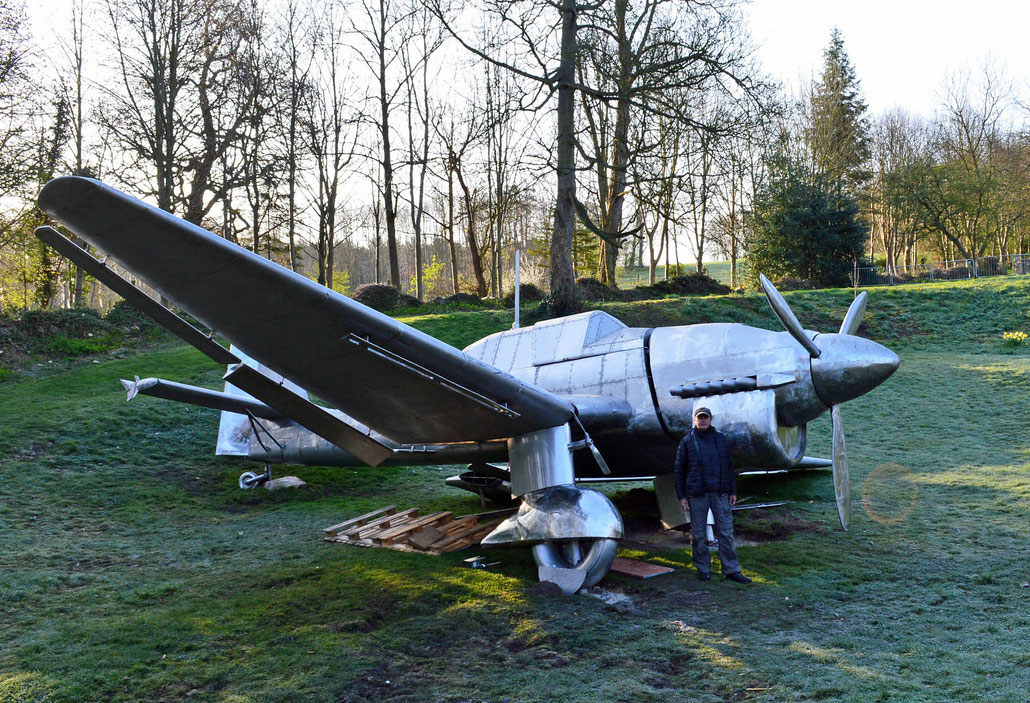
Only one day left to finish ! Hex in front of his sculpture DOWN.TWO.EARTH. at Burghley House.
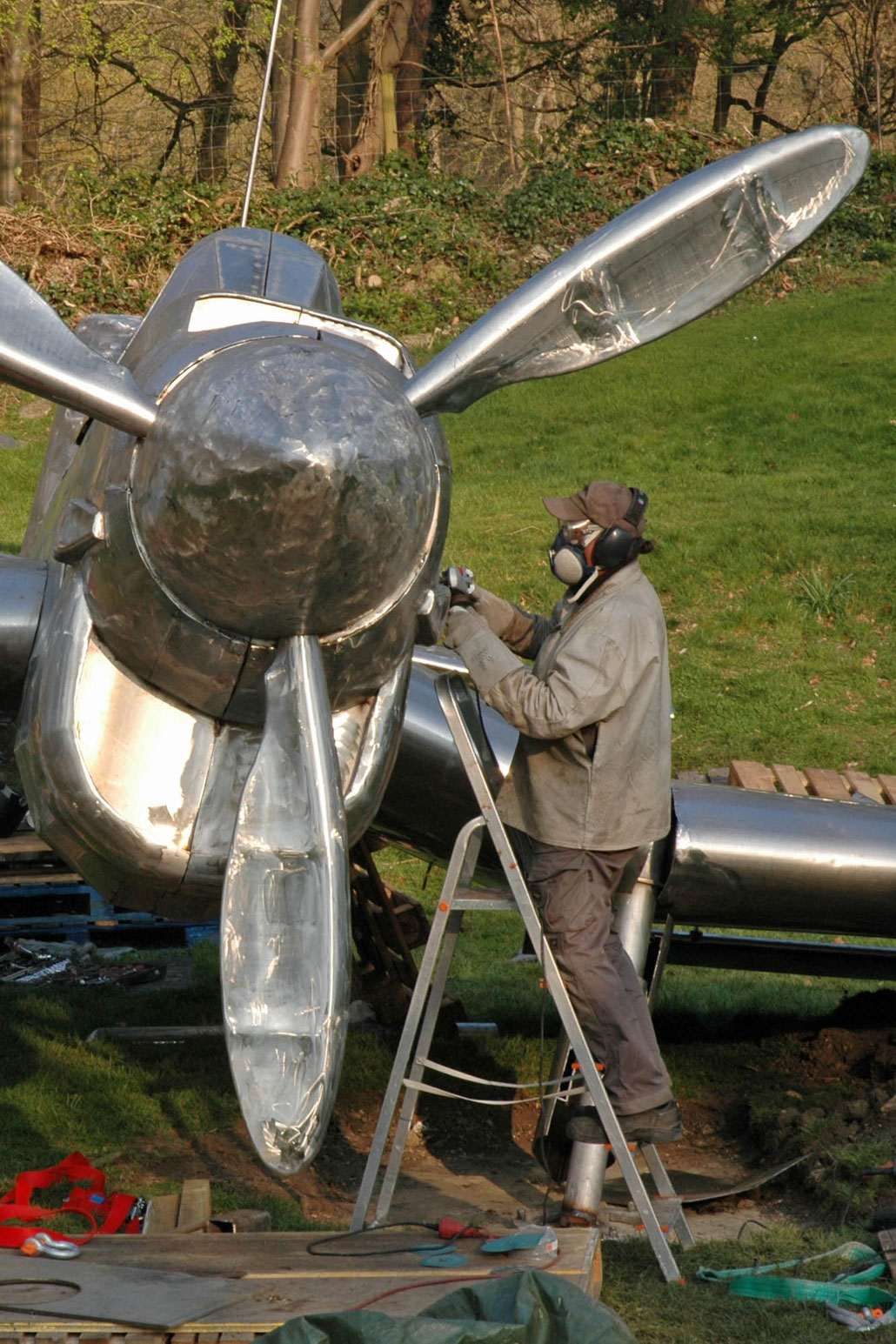

Franz Radziwill " Flandern - wohin in dieser Welt " 1940, Paul Nash " The Messerschmitt in Windsor Great Park " 1940

Raymond Dominic Agius " Stuka Playground "
Art is always the answer on art
The STUKA as a contemporary theme
There are plenty more or less well known air planes that took part in the battles of WW II.
Many people are familiar with names like “Spitfire”,“Hawker Hurricane”, “Mustang” or “Lancaster”. Nearly everybody has seen movies in which those war birds were starring but the fame of those planes always stayed within the borders of military history.
It was the German soldier and later artist Joseph Beuys, born 1921, who in his very early days recognized this kind of “evil sexiness” of the Junkers JU 87.
This dive bomber is called STUKA which means STURZKAMPF- Flugzeug in German. In contrast to most of the German perpetrators who shortly after the war couldn´t remember anymore what they did Beuys seeked some evil credits. Thus highlighting the difference between him as “ the bad guy“ and the transformation into an modern art shaman. He decorated himself postwar with two of the highest “ Eisernes Kreuz “ medals. He blew up the lowest of the medals for the wounded which he really received to the highest level and so on.
Joseph Beuys wanted to evoke the impression that he was one of the very bad ones.
It was a means of his self mythologization as a bloody black falcon that fell from the sky and turned into a snow white dove. The core of his post war success as an artist is the so called “Tartar Legend”. He invented the story that he was a STUKA pilot who was shot down over Russia, severely injured, rescued by nomadic Tartars, wrapped in fat and felt and bespoken and thus healed by a shaman.
In reality Beuys was the gunner in that STUKA, they crashed while landing near the German airfield, he only suffered from a broken ankel and was released 12 days later from military hospital to fight again as a paratrooper. By spreading his invented story hundreds of times he also introduced the STUKA into contemporary art history. That is the point I am interested in.
“Joseph Beuys and the STUKA” became a theme for a lot of artists before I started to work on it. One of the first art works by the Austrian artist Gottfried Helnwein that I saw was “Before the crash I”. A painting showing Joseph Beuys in Luftwaffe-Uniform in front of a STUKA. Helnwein made a series of Beuys related paintings combining him with Mickey Mouse, Donald Duck or Arno Breker who was Hitler´s beloved sculptor.
Already in 1964 Gerhard Richter picked up the STUKA – theme of Joseph Beuys by taking a original war photo and repainting it. The same photo was used later for covers of Punk records like “Stukas über Shoreditch” by Johnny Throttle and Wild Billy Chyldish´s “ Joseph Beuys flies again”. Robert Adrian ironically calls his crashed STUKA-sculpture “Great moments in modern art”, Jörg Immendorf paints “ Stuka-Flieger Beuys”, Katharina Wahl cuts a STUKA out of a carpet and creates a “Carpet Bomber”, Raymond Dominic Agius calls his painting “ STUKA Playground” and Anselm Kiefer worked in manifold sculptures on the war plane theme, Robert Longo still does draw military aircraft, just to mention a few.
Sebastian Romo is the first artist to go monumental with a STUKA sculpture. His wooden STUKA hanging upside down from the ceiling is executed in scale 1:2 and with a wing span of 7 m already impressive. “Death at / in blossom” in its dramatic position is awe inspiring.
My sculpture “DOWN.TWO.EARTH.” is created in original dimensions to demonstrate the realistic relation between the human body and that awful weapon on one hand. On the other hand it means to scale up myself from a boy glueing together toy STUKAS in 1:48 to a grown up German “ Post Beuys” sculptor executing the STUKA in original size.
HEX

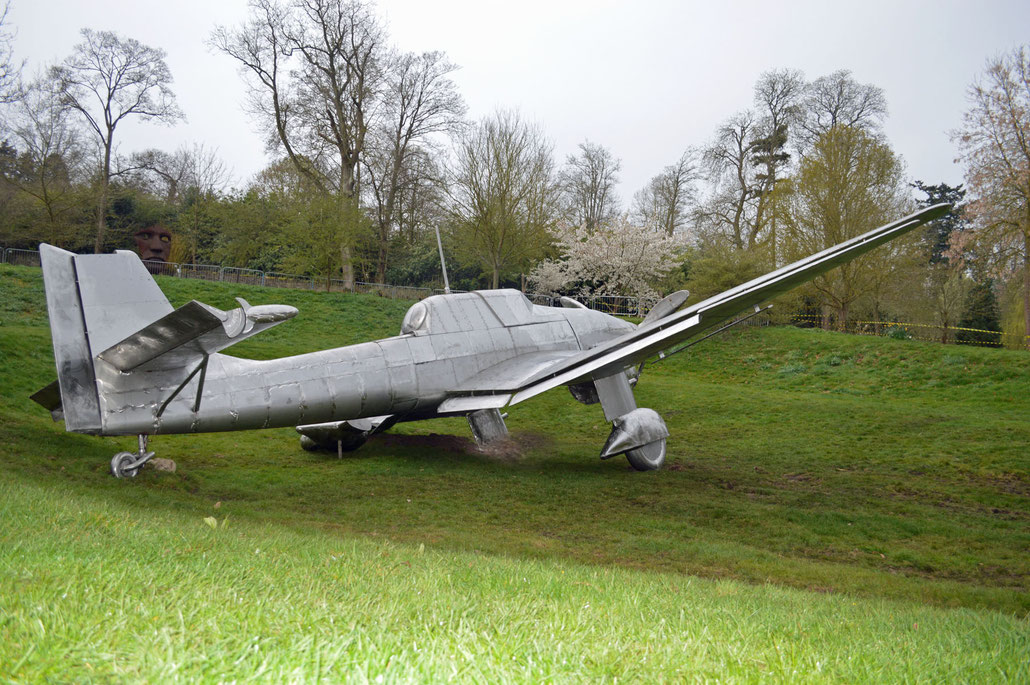


DOWN.TWO.EARTH.
A contemporary reminiscence
Stainless steel sculpture of a Junkers JU 87 STUKA in original size
Spring 2019
The basic idea of building a huge model of a STUKA dive bomber came in my mind about 45 years ago. At the age of 10 I did not intend to become an artist but wanted to be a farmer.
Now, as a sculptor, I know that every artist is his own psychotherapist, too. This sculpture called “DOWN.TWO.EARTH.” is the very first of about 1230 pieces I already executed in the past 30 years that has a direct and straight connection to my childhood.
The whole project can be separated into 3 layers of reasons why I did this sculpture. These layers of private family history, German art history and British military history added up one by one over the years.
The first layer can be called : Being my father`s son
I actually do not know too much about my father. For over 20 years we very hardly talked because I severely opposed him from my earliest days on. The last 7 years of his life, he died in 2000, we had a warm and respectful relationship because we both changed deeply and worked hard on our points of view.
Born in 1923 in East-Prussia my father volunteered at age 10 for the Hitlerjugend, at age 17 for the Luftwaffe, he took all the lessons over 3 years to become a STUKA pilot but became a gunner finally, he fought in Africa for 12 days and from 1943 to 1946 he was a POW in British and American camps. From 1946 until 1988 he worked as an interpreter for the British and American Forces and worked several month every year in the UK or USA.
So he spent about 55 years of his life in male dominated structures that were based on ranks, orders and obedience . He imposed these structures on our family life. For a long time he had absolutely no respect for women and his first three children, my sisters, suffered from this.
His first born son, my older brother, was born severely handicapped. So I was, as child number 5, the first possible “soldier” for him. I never obeyed, always opposed and he never could break my will since I was 5 years old. No good for a soldier, I denied my draft when I turned 18. Between age 8 and 14 I got six scale models of a Junkers JU 87 STUKA as a gift from my father. The STUKA was the only and single object he was possessed by. The only thing he really loved, the only “thing” that had a personal deeper meaning to him.
In 1980 he bought ZIRKOLI plans for a STUKA in scale 1:5 in America for me. I used these plans when I started my first 1:1 effort in 2009 and they are still hanging on my studio walls.
The STUKA is the only “thing” that connects me to my father. Except some four or five pictures and some letters the ZIRKOLI plan is the only thing I still own from him.
This is the basic layer.
The second layer: Two father figures in change
When I grew up in the 70´s and 80´s the artist Joseph Beuys was omnipresent. He was the German Andy Warhol. He was provoking scandals, speaking against the normal way of living and he was demonstrating for peace on the streets and a founding member of the German Green Party. For all that I loved him and his work. He appeared to be a true and upright rebel. To me he seemed to be the total opposite to my father.
Since my very early years I had a vague idea what a “Nazi” is and I knew that my father was one. For a very long time I believed that my father was the reincarnation of evil. I did not want to hear his lies about the war, his ideas of a supreme race and all his ideas that were the result of social darwinistic indoctrination. Opposition and pure hate was all I felt for him for a long time.
In the end I learned something very precious from him: Everybody can change at every point in his life. My father worked hard on himself and became a pretty liberal, open minded, warm and lovely person at the end of his life.
My attitude towards Joseph Beuys changed over the years, too.
I learned that his total career based on a chain of lies. He lied about his place of birth, about his uncle whom he introduced as his father over decades, he faked his high school degree, he invented his membership in a travelling circus in 1939, he decorated himself with the highest military medals which he bought on the flee market and much more.
His central lie of his life was the so called “Tartar Legend”. Beuys said and wrote a hundred times that he was the pilot of a STUKA and shot down by Russians. In truth he was just a gunner – like my father. But Beuys built up his whole career around this “legend”.
Beuys was born in 1921, my father was born in 1923. Both made a career in the HJ, both volunteered for the “Luftwaffendivision Hermann Göring”. To become a member of this unit, which was formed to commit war crimes, to volunteer was not enough. At this young age you already had to be a “ honorable member of the movement”. Beuys and my father never met but made the same educations to become a STUKA pilot. The STUKA remained in their heads for the rest of their lives. Both became gunners, not pilots and both went in February 1943 to the south of Italy.
I think that Beuys kept his indoctrinated belief in race until the end of his life. He always stood close to “ brownish” organisations , he had steady contact to former SS members and never seeked distance to the things he did during war. In opposite he even invented war stories and medals of honor. Like millions of Nazi Germans after the war, Beuys invented the myth that he was the “Leidensmann”, the one that was really suffering. They saw themselves as the true victims of WW2.
Beuys was not a German Andy Warhol. Beuys was selling old thoughts in a new wrapping until the end of his life. Several artist like Robert Adrian, Jörg Immendorf, Sigmar Polke, Gottfried Helnwein or Gerhard Richter already worked on that Beuys- Stuka – theme.
The third layer: Great Britain
My father used to say: “The English language saved my life !”
As a kid he learned basic English in school and listened to BBC radio. When he became a British POW in March 1943 in North Africa and later in Scotland he already worked as a translator in the camps. As my father was partly of Polish origin he was offered to be released from the British prison camp if he would volunteer for the Polish Squadrons in Britain. He refused that.
From July 1943 until January 1946 he was a POW in two camps in Alabama. In 1946 he was handed over to French authorities and became a POW there. He fled with 4 comrades, swam thru the river Rhein and was captured by American MP in the woods south of Munich close to an ammunition storage. My father could speak English fluently, his comrades were shot on the spot. English saved his life !
The next day my father started to work for the American Forces until 1988. He was allowed to build a hut out of wooden artillery boxes in the woods. 11 years later he built a real house half a mile away from that spot and I was born in this house in 1964. Until the late 90´s his hut was still standing in the woods.
In 2011 I became an Associate of The Royal British Society of Sculptors, in 2012 I received the three month Brian Mercer Bronze Residency and in 2016 I was elected Fellow.
I was invited to show a large outdoor sculpture in a beautiful setting at the University of Leicester in 2014. This sculpture went to the sculpture garden of Burghley House the following year. When I chatted a bit with Michael Shaw, the curator there, I told him about my STUKA project. I mentioned that I gave up the last effort to build it in original size in 2009. One year later Michael remembered our talk, called me and said that he would be willing to show it. The next day I started again with the “DOWN.TWO.EARTH.” project.
The following statement is a bit generalized. When Germans think about Brits the Royal Family comes to their minds, British humor and Mr. Bean, Rolls Royce, James Bond and a good football league. When Brits think about Germans they might start with Mercedes, Porsche and BMW but pretty fast it is about the Battle of Britain. The famous movie from 1969, modern movies like “Dunkirk” from 2017 or the latest BBC series “ SS-GB” keep those memories fresh until today. The STUKA is the most outstanding symbol for the German war machinery and “The Blitz”.
DOWN.TWO.EARTH.
A crashed STUKA as a symbol of the defeat of an evil ideology
and
as a memorial against war







For more pictures of the Stuka sculpture please klick the 3 lines in the upper left and go to DOWN.TWO.EARTH.
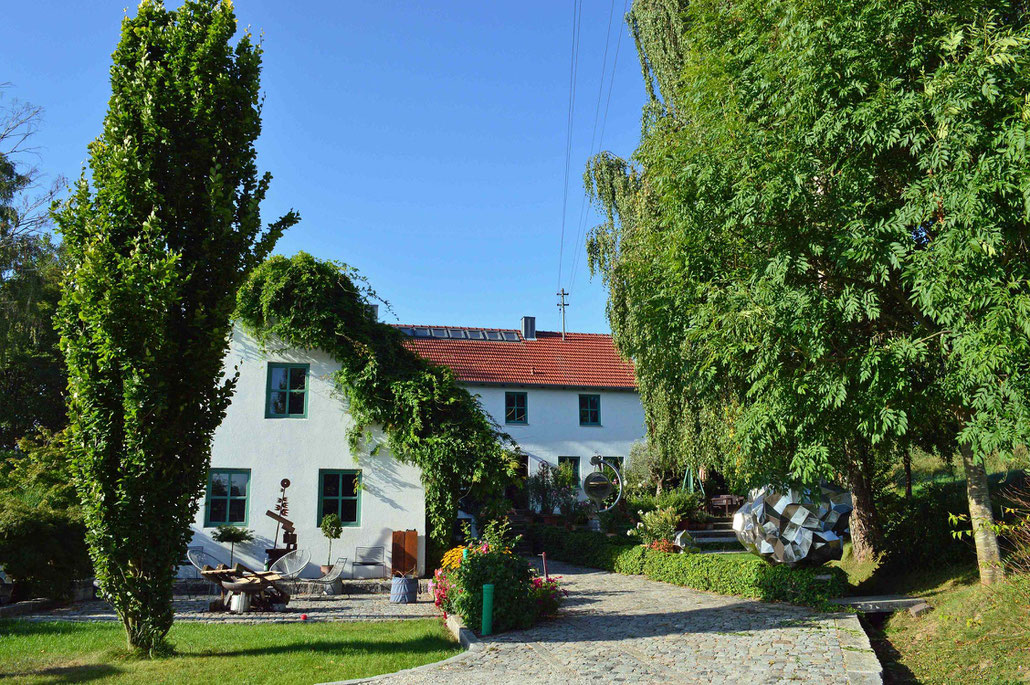
HEX
Edelstahl ° Marmor ° Bronze ° Aluminium ° Stainless Steel ° Marble ° Bronze ° Aluminum
Der Bildhauer HEX lebt und arbeitet nördlich von München. Von 1989 bis 2011 arbeitete er ausschließlich in Stahl und Edelstahl. Seit der Aufnahme in die ROYAL BRITISH SOCIETY OF SCULPTORS 2011 und dem anschließenden Stipendium hat sich sein Materialspektrum um Bronze und Marmor erweitert. Dieses Stipendium für Bronzeguss, welches vom BRIAN MERCER CHARITABLE TRUST finanziert wird, führte HEX 2012 für 3 Monate in die Bildhauermetropole Pietrasanta / Toskana, wo er seither regelmäßig arbeitet. 2014 und 2016 wurde er eingeladen an bedeutenden Gruppenausstellungen der University Of Leicester ( Kuratorin Helaine Blumenfeld OBE ) und des Burghley House teilzunehmen. Hierfür entwickelte der Künstler HEX die ersten Skulpturen der Asteroid Serie, welche in England zu großem Erfolg führten. Im Dezember 2016 wurde HEX zum Fellow ( F.R.B.S. ) der RBS gewählt. www.rbs.org.uk
Ab April 2019 wird die Flugzeugskulptur "DOWN TWO EARTH" im Skulpturenpark von Burghley House zu sehen sein.
Seit 2005 ist HEX Mitglied von sculpture-network, einer Organisation mit Sitz in München die von Ralf Kirberg gegründet wurde und inzwischen ca. 1100 internationale Mitglieder hat.
The sculptor HEX lives and works north of Munich. From 1989 until 2012 he solely worked with steel and stainless steel. Since becoming a member of the ROYAL BRITISH SOCIETY OF SCULPTORS in 2011 and receiving a residency in 2012 Bronze and Marble added to his spectrum of materials. This Bronze Casting Residency, sponsored by the BRIAN MERCER CHARITABLE TRUST, brought him to Pietrasanta / Tuscany for 3 month. He returns to work there several times a year, since. In 2014 and 2016 he was invited to important group exhibitions at the sculpture gardens of the University Of Leicester ( curated by Helaine Blumenfeld OBE ) and Burghley House. For these shows the artist HEX made the first pieces of the Asteroid Series which became a great success in England. In December 2016 HEX was elected Fellow ( F.R.B.S. ) of the RBS. www.rbs-org-uk
From April 2019 on the war plane sculpture "DOWN TWO EARTH" will be on Show in the Burghley House sculpture park.
Since 2005 HEX is a member of sculpture-network, a Munich based Organisation with meanwhile 1100 international members.

Dr. Helaine Blumenfeld OBE and HEX with one of his first bronzes THREE APUANIC FORMS in the background.
Das Brian Mercer Bronzeguss-Stipendium 2012 in der Fonderia Artistica Mariani Pietrasanta
Das Brain Mercer Bronzeguss-Stipendium trägt sämtliche Kosten für den dreimonatigen Aufenthalt eines Bildhauers in Pietrasanta ( Toskana ) um ihm die fabelhafte Gelegenheit zu geben, unter der Anleitung von Meistern, mit Bronze zu experimentieren. Ziel ist es einen Bildhauer, ohne vorherige Erfahrung im Umgang mit Bronze, in die Lage zu versetzen die technischen Aspekte des Arbeitens in Bronze zu erlernen und dadurch seine Entwicklung voran zu treiben und seine praktischen Fähigkeiten auszubauen. Das Stipendium eröffnet dem erfolgreichen Bewerber die Möglichkeit Seite an Seite mit den Artigiani der berühmten Fonderia Artistica Mariani zu arbeiten und hierbei den Ablauf des Wachs-Ausschmelz-Verfahrens, vom Entwurf des eigenen Modells in Ton und Wachs bis hin zu den letzten Arbeitsschritten mit Treibeisen und Patina, kennenzulernen. Das Brian Mercer Bronzeguss-Stipendium wurde 2008 an Samantha Donnelley, 2009 an Briony Marshall, 2010 an Anne Mercedes, 2011 an Kate McLeod, 2012 an HEX, 2013 an Richard Stone, 2014 an Richard Jackson, 2015 an Alexandra Harley und 2016 an Stephen Duncan vergeben und findet jeweils im Folgejahr statt.
The Brian Mercer Bronze Casting Residency 2012 at the Fonderia Artistica Mariani Pietrasanta
A fully supported scholarship to experiment with bronze under instruction from master craftsmen for three months, the Brian Mercer Bronze Casting Residency in Pietrasanta (Tuscany) is a fabulous opportunity for a professional sculptor. The aim is to enable a sculptor without previous experience of working in bronze to learn the technical aspects of the casting process, thus expanding their skills and developing their practice. The residency offers the successful candidate the opportunity to work alongside the artisans of the renowned Fonderia Artistica Mariani, developing an understanding of the lost wax process, from the creation of their own models in clay and wax to the finishing stages with chisel and patina. The Brian Mercer Casting Bronze Residency in Pietrasanta was awarded in 2008 to Samantha Donnelly, in 2009 to Briony Marshall, in 2010 to Anne Mercedes, in 2011 to Kate McLeod, in 2012 to HEX, in 2013 to Richard Stone, in 2014 to Richard Jackson, in 2015 to Alexandra Harley and in 2016 to Stephen Duncan. The Residency always takes place in the following year.
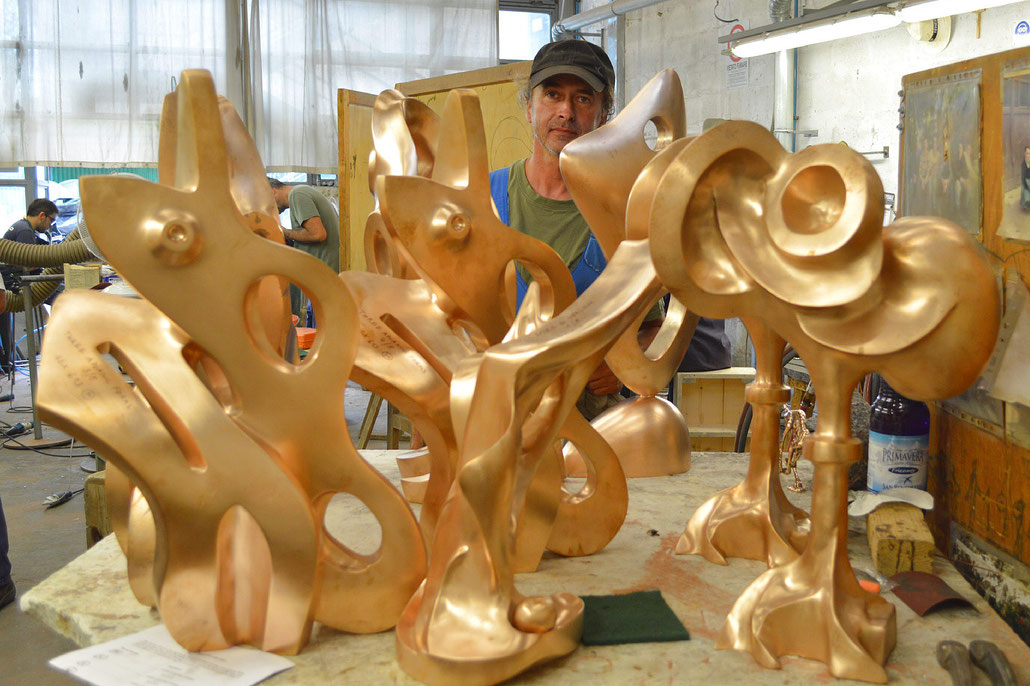
page 1 / 10
to turn pages please klick the lines on the upper left
HEX F.R.B.S.
Perlestrasse 16
84072 Au / Hallertau, Germany
mr.hex@weihenstephan.org
www.rbs.org.uk
www.sculpture-network.org





